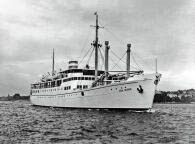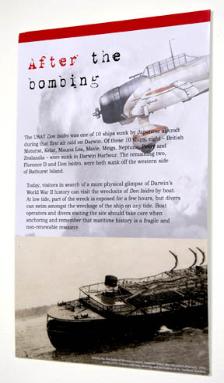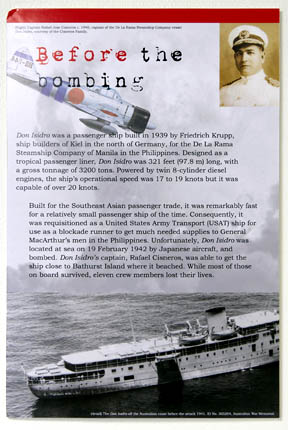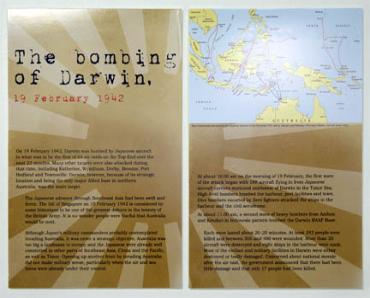

Granddaughter’s search for WWII ship that her grandfather
captained leads to ABB
By Ken Graber and Remy Mills
captained leads to ABB
By Ken Graber and Remy Mills




| (Clockwise) ABB's Turbocharging Equipment Powered the Don Isidro, a Passenger/Cargo Ship; Small commerative display 4 BoD 19 Feb 2011 - The loss of the Don Isidro; file from the Australian commemorative exhibit from the bombing of Darwin, AU.; |
getting pictures of the ship Don Isidro from your report on ritime/Turbocharging.
Here’s why I want the picture.
To make a long story short, my grandfather, Rafael J. Cisneros, was a WWII
civilian hero. He was a Captain of a passenger/cargo ship that carried about
500 passengers. The U.S. military basically ‘drafted’ him because he knew the
Trade Winds, and they needed his help by using his ship to bring supplies to
the Philippines via Australia, as General MacArthur and his troops were
starving and running out of food.
My grandfather negotiated with the military and told them he would do it on the
grounds that he, his wife and their 14 children become U.S. citizens and would
be able to graduate from the finest schools - USC was my Dad’s choice. (My
Here’s why I want the picture.
To make a long story short, my grandfather, Rafael J. Cisneros, was a WWII
civilian hero. He was a Captain of a passenger/cargo ship that carried about
500 passengers. The U.S. military basically ‘drafted’ him because he knew the
Trade Winds, and they needed his help by using his ship to bring supplies to
the Philippines via Australia, as General MacArthur and his troops were
starving and running out of food.
My grandfather negotiated with the military and told them he would do it on the
grounds that he, his wife and their 14 children become U.S. citizens and would
be able to graduate from the finest schools - USC was my Dad’s choice. (My
ABB’s profile on “A Century of
Turbocharging” contains critical
artwork Remy Mills has not been able
to find – until now
New Berlin, WI, USA, August, 2010 --
Remy Mills, employed at Harold Wells
Associates, a manufacturer’s
representative based in southern
California, U.S., recently began a
search for photography of the ship her
grandfather captained during WWII.
That search led to ABB.
Here is her chronicle, in her words; it
is a story on how the war interlaced
countries, people – and led to a new
life, and education, for Ms. Mills’
father and siblings:
“What I was looking for is maybe
Turbocharging” contains critical
artwork Remy Mills has not been able
to find – until now
New Berlin, WI, USA, August, 2010 --
Remy Mills, employed at Harold Wells
Associates, a manufacturer’s
representative based in southern
California, U.S., recently began a
search for photography of the ship her
grandfather captained during WWII.
That search led to ABB.
Here is her chronicle, in her words; it
is a story on how the war interlaced
countries, people – and led to a new
life, and education, for Ms. Mills’
father and siblings:
“What I was looking for is maybe
Dad was of age and he fought for the U.S. Army during WWII and that’s why my siblings and
I are U.S., citizens even though most of us were born in the Philippines). “The ship, Don
Isidro, eventually was sunk near Australia by kamikaze pilots. There are a few books
written about the ordeal. Anyway, I was on the computer last night and decided to search
for a picture of the ship. Lo and behold, I found it! It happened to be in a report by ABB
Turbosystems! I was totally blown away! It sure is a small world! ABB and my grandfather
and I have come full circle. Is that unbelievable?!
“Don Isidro was a fast ship (due to the ABB turbocharger) and, due to its size, was able to
maneuver easily as they zigzagged across the ocean to make it harder for Japanese
submarines to detect them. Since it was a passenger/cargo ship, they had no weapons.
They had a handful of U.S. military with them to guard them; therefore, they had a limited
amount of weapons.
“Their greatest defense was to zigzag through the water. Alas, as they got closer to northern
Australia, kamikaze pilots spotted them. They got shot at, but my grandfather was able to
zigzag easily all the while he was on the radio yelling, “May Day, May Day!” as they got
closer to Bathurst Island – Australia. Then a kamikaze pilot flew into the engine stack
where the ship burst into flames. Another pilot flew onto another part of the ship.
“They were only a few miles away from the island, when my grandfather and his crew had
to abandon ship. It was night time and they were swimming in shark-infested waters for 10
hours, until almost all of them made it on shore in the morning. There were 10 men missing
originally, but they found them all. The current had brought the still-burning Don Isidro
almost to the shore.
“They were saved the next day, but not without more enemy pilots still shooting at them.
Nowadays, the area is a divers’ destination and, on a clear spring day, the engine stack
and mast are visible from the shore on Bathurst Island.
I are U.S., citizens even though most of us were born in the Philippines). “The ship, Don
Isidro, eventually was sunk near Australia by kamikaze pilots. There are a few books
written about the ordeal. Anyway, I was on the computer last night and decided to search
for a picture of the ship. Lo and behold, I found it! It happened to be in a report by ABB
Turbosystems! I was totally blown away! It sure is a small world! ABB and my grandfather
and I have come full circle. Is that unbelievable?!
“Don Isidro was a fast ship (due to the ABB turbocharger) and, due to its size, was able to
maneuver easily as they zigzagged across the ocean to make it harder for Japanese
submarines to detect them. Since it was a passenger/cargo ship, they had no weapons.
They had a handful of U.S. military with them to guard them; therefore, they had a limited
amount of weapons.
“Their greatest defense was to zigzag through the water. Alas, as they got closer to northern
Australia, kamikaze pilots spotted them. They got shot at, but my grandfather was able to
zigzag easily all the while he was on the radio yelling, “May Day, May Day!” as they got
closer to Bathurst Island – Australia. Then a kamikaze pilot flew into the engine stack
where the ship burst into flames. Another pilot flew onto another part of the ship.
“They were only a few miles away from the island, when my grandfather and his crew had
to abandon ship. It was night time and they were swimming in shark-infested waters for 10
hours, until almost all of them made it on shore in the morning. There were 10 men missing
originally, but they found them all. The current had brought the still-burning Don Isidro
almost to the shore.
“They were saved the next day, but not without more enemy pilots still shooting at them.
Nowadays, the area is a divers’ destination and, on a clear spring day, the engine stack
and mast are visible from the shore on Bathurst Island.
“It is because of my grandfather’s actions that he was declared a WWII hero….not only because he
volunteered to be a cargo runner for the U.S. military. My grandfather died 16 years later of a stroke on another ship, Dona Maria, while
they were in the middle of a cruise.”
ABB is at work, helping Ms. Mills with the artwork she has requested. Here is the online report that helped her find her way to ABB, and
make the request: http://www.maxstandridge.net/civhero.htm
volunteered to be a cargo runner for the U.S. military. My grandfather died 16 years later of a stroke on another ship, Dona Maria, while
they were in the middle of a cruise.”
ABB is at work, helping Ms. Mills with the artwork she has requested. Here is the online report that helped her find her way to ABB, and
make the request: http://www.maxstandridge.net/civhero.htm

One of the more interesting aspects of working in
Customer Service for a large company is that you get
to build “phone friendships” with people all over the
United States and in some cases, globally. I’ve been
talking to Remy Mills for a number of years now,
working in Parts Logistics Customer Service for
ABB, Inc and Remy works for one of our
manufacturer’s reps in California, Harold Wells &
Associates. The downside of the relationship is that
conversation is often limited to work. Knowing my
interest in history and genealogy, a co-worker in my
New Berlin office spotted the accompanying story
about Remy’s search for photographs of the vessel
her grandfather captained during the WWII years in
the Philippines. Her grandfather, Rafael Cisneros
was born in Spain but lived in the Philippines with
his wife and family where he worked for a company
that ran a fleet of passenger ferry vessels. His ship,
the Don Isidro, was particularly fast and nimble.
Customer Service for a large company is that you get
to build “phone friendships” with people all over the
United States and in some cases, globally. I’ve been
talking to Remy Mills for a number of years now,
working in Parts Logistics Customer Service for
ABB, Inc and Remy works for one of our
manufacturer’s reps in California, Harold Wells &
Associates. The downside of the relationship is that
conversation is often limited to work. Knowing my
interest in history and genealogy, a co-worker in my
New Berlin office spotted the accompanying story
about Remy’s search for photographs of the vessel
her grandfather captained during the WWII years in
the Philippines. Her grandfather, Rafael Cisneros
was born in Spain but lived in the Philippines with
his wife and family where he worked for a company
that ran a fleet of passenger ferry vessels. His ship,
the Don Isidro, was particularly fast and nimble.


U.S. General MacArthur and his troops were trapped in the Philippines because of a blockade by the Japanese Navy and unable
to resupply their troops who were in serious danger of starving for lack of rations on Bataan and Corregidor. The only viable
option for bringing in supplies that might evade Japanese interference was to use civilian vessels. The Don Isidro and her
Captain Rafael J. Cisneros, agreed to undertake the dangerous mission but the Captain had one condition before he agreed and
that was US Citizenship for him and his family, along with a guarantee of a college education for his children at the schools of
their choice. A small price to pay to save the lives of 50,000 American soldiers. There were 14 children in his family, some of
whom had families of their own, including Remy’s father who married a Filipina.
A quote from Remy “I knew about the books written about my grandfather’s heroic actions during WWII. I have copies of the
book ‘Destination Corregidor” but wanted more. That’s when I came across the ABB report which started the ball rolling.
My Dad’s family arrived in the US right after the war. They all came at different times as my grandfather had 14 children and
some of them already had families.
"After the war, my grandfather continued being a captain of a cruise ship ‘Dona Maria’ going from Australia, Philippines, etc. In
the early 50’s, my Dad happened to be a passenger on the ship while it docked in the Philippines. My Uncle, Romeo - my Mom’s
brother - was just employed as the Engineer on the ship. My Mom and her family were seeing Romeo off when my Dad saw my
mom and had to meet her as he thought she was beautiful.“
Remy and I have exchanged e-mails on this subject and her family history is very interesting on both sides for her and her
husband. Both of us share an interest now in family stories and although the Don Isidro was lost, through ABB Turbo out of
Switzerland, she was able to find the photos of the ship and has also been contacted by divers who have photographed the
wreck off Bathurst Island.
Too often we forget the unrecorded acts of people who show bravery facing great personal danger. The captain and crew of the
Don Isidro were attacked by kamikaze planes and the ship sunk. Fortunately, most of the crewman survived. .—Debby Tewes